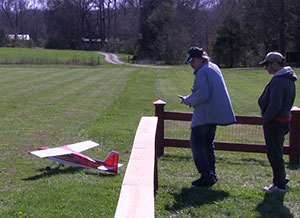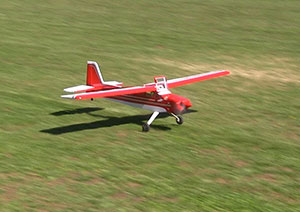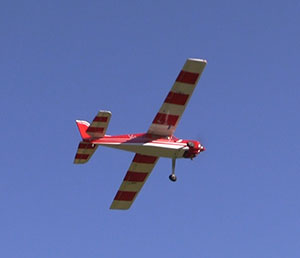



Text, photos by Tom Hintz
Flight Video by Clark Ponthier
Posted – 4-12-2018
At this writing, 2018 weekends, prime flying days for me, have been filled with rain, wind and cold, frequently with the first two accompanying the third. What seems more and more like a weather-borne conspiracy has forced me to repeatedly push the re-maiden of the rebuilt Hangar 9 10cc Valiant back another week. In the first Hangar 9 10cc Valiant segment I opted to challenge the wind with terrible results. See the Resources section below for a link to the original build and maiden story.
Now, a new fuselage and much checking and rechecking made sure no hidden damage was transferred to the new Hangar 9 10cc Valiant rebuild. Once again, the Hangar 9 10cc Valiant was ready to get back in the air, again postponed a few times by inclement weather.
The first decent-looking weather day dawned with more wind than I wanted, and the local weather prognosticators predicted (big surprise) but I was ready to get the re-maiden in the books. Between the rather stout gusts, the wind speed dropped to sort-of reasonable levels. RC pilots are hopelessly optimistic, believing they can fly safely between the gusts. I’d like to say I am above such rushes of inflated ego but the video accompanying this story blows my cover on that count.
Another encouraging factor was the NGH GT09 Pro 9cc Gas Engine that was perking along nicely through several test-runs in the yard. During the brief original maiden, the power delivered by the new NGH GT09 Pro 9cc Gas Engine was remarkable. As I prepared for the re-maiden flight, having enough power was not a concern.

For the last 30-some years I have routinely set my planes up with as much control surface movement as I could get. I have always liked having the extra throw and learned to modulate those controls manually in the era before dual rates, expo and other electronic flight aides. However, the Hangar 9 10cc Valiant was about to remind me that not all models react alike. Prior to the re-maiden flights, I created a dual rate with the surface throws set up per the instruction manual recommendations and would find the Hangar 9 10cc Valiant likes them, even in moderate winds and still flies great.
The elevator is rather sensitive at large throws but is manageable with enough expo to help achieve the feel to which you are most accustomed. In most cases, the rudder can get downright frightening when the recommended amount of throw is exceeded, as I did initially. The Hangar 9 10cc Valiant is the poster child for rudder effectiveness so it is highly recommended that you at least begin with the throws listed in the manual and dial in healthy amount of expo, at least for the initial trim flights. You can then work with slowly increasing the throws and expo to fit your needs. After the re-maiden flights, I began reducing overall rudder travel to search for the best setting for my style of flying. This kind of adjust and test procedure can help you dial in a plane to find the “sweet spot” as it relates to your flying skills and preferences.
We must keep in mind the overall size of the Hangar 9 10cc Valiant. Compared to its much larger 30cc brother the smaller version will be more sensitive in the air and react to winds more than the 30cc size. This is not an issue with this plane but rather a real-world flying characteristic that can be applied to all planes in this size. Smaller planes can be more difficult to fly because their reduced size/mass allows them to react wind more than most larger planes. This doesn’t mean you should not buy a plane like this, you just need to keep its size in mind when setting up the controls and choosing wind conditions with which you are comfortable.

On the first take off run the Hangar 9 10cc Valiant weather-vaned a little and got aimed across the runway so I aborted and let it run into the grass surrounding the field. It did trip on the longer grass and flip over but sustained no damage.
The next takeoff was better but after breaking free of the ground it needed considerable up trim, so I kept the power on, got it up to a safer altitude and added the trim. With it flying much better I made a pass down the runway and we could see the issue. The magnetically-secured windshield was standing up and was causing the aerodynamics issue that needed the up trim. I was doubting how much the windshield really had to do with it but when we got it back into the correct position for the next flight, the Hangar 9 10cc Valiant flew totally different, and the trims needed to be set back to where they had started to fly straight and level. I will wait until I get a lower wind day to finalize the control surface setups.
I later found that I had installed the windshield from the crashed fuselage and a small break in the structure under the covering prevented it from sitting flat on the surfaces with magnets set into them. Installing the new windshield cured the trim problems and it stayed put through all subsequent flights.
Other than the Aero problem the Hangar 9 10cc Valiant handled the bumpy winds well. The NGH GT09 Pro 9cc Gas Engine was having no trouble pulling the plane around including into the occasionally stiff wind. It was becoming clear that my “all I can get” theory of control surface setting wasn’t the hot setup on the Hangar 9 10cc Valiant.
Day two of the re-maiden went very well. I changed out the APC 12X6 prop for a wooden Vess 12X6 Sport Series prop and both the Hangar 9 10cc Valiant and the NGH GT09 Pro 9cc Gas Engine seemed to like it. The Hangar 9 10cc Valiant will never be a rocket but it seemed noticeably faster than it was the day before with the APC prop.
I set up one of my dual rate states with the factory high throws that reduced the elevator and rudder considerably. The Hangar 9 10cc Valiant likes a shallow takeoff angle and it also takes off well with the mid flap setting. While the elevator was definitely less sensitive but effective, the rudder remains a bit touchy. If you are not used to flying with the rudder you need to A: learn to use it!! B: dial in some expo to soften the rudder response while you get more comfortable using that control.
One thing that seems different on the Hangar 9 10cc Valiant as opposed to the Hangar 9 30cc Valiant is how sensitive the rudder is at lower speeds such as while landing. Use small rudder inputs and let the Hangar 9 10cc Valiant come around on its own. Too much rudder starts a yaw and bank if you get carried away with moving the sticks. A little bit goes a long way with the Hangar 9 10cc Valiant and when you get used to it controlling landing direction is easy and looks smooth.
The Hangar 9 10cc Valiant is a great flying airplane that makes a good platform with which to get into gas engine RC flying. The only caveat is sticking with the control throws listed in the instruction manual. At those settings the Hangar 9 10cc Valiant will be easy to fly for RC pilots with moderate experience and a little help to get started.
The Hangar 9 10cc Valiant is a great plane with which to learn rudder and flap use. Both systems can be toned down to let you get the feel of using the rudder and flaps without sacrificing control. As your skills and confidence grow you can “liven” the Hangar 9 10cc Valiant up with a little more control surface throw. Make small changes to find the amount of throw you like.
Despite its good manners the Hangar 9 10cc Valiant is more aerobatic than most high wing planes. Here again, you can manipulate the controls to get used to putting the Hangar 9 10cc Valiant in various attitudes often used to enter or exit from aerobatic maneuvers.
This is one high wing plane you will not be trying to sell when you get bored with it. The Hangar 9 10cc Valiant has all the capabilities needed to keep your interest alive and well.
Hangar 9 10cc Valiant Build and Maiden Flight – Click Here
Have a comment on this Review? - Email Me!